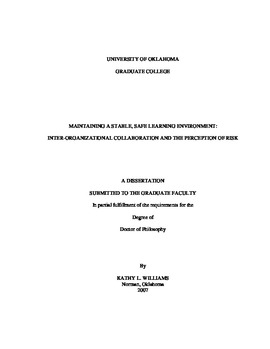| dc.contributor.advisor | O'Hair, Henry D., | en_US |
| dc.contributor.author | Williams, Kathy L. | en_US |
| dc.date.accessioned | 2013-08-16T12:20:40Z | |
| dc.date.available | 2013-08-16T12:20:40Z | |
| dc.date.issued | 2007 | en_US |
| dc.identifier.uri | https://hdl.handle.net/11244/1197 | |
| dc.description.abstract | This study revealed that 35% (22) public school districts and non public schools had a minimal school safety and security planning process, 44% (27) had an evolving process, and 21% (13) had an exemplary process. It displayed that the public school districts and non public schools that established safety and security as 'part of the system' (Systemic Approach) had an evolving or exemplary process. It determined that public school districts and non public schools that utilized environmental scanning and boundary spanning (Inter-organizational Collaboration) enhanced their school safety and security planning process. It also revealed that if the educational leaders' perception of risk was well developed the school safety and security planning process was more comprehensive. Lastly, the study determined that location may have an influence on the school safety and security planning process. However, public vs. non public, school affiliation, available monies, community support, and other factors may be as influential. | en_US |
| dc.description.abstract | The school safety and security planning process is important because it directs the educational organization's ability to maintain a stable safe learning environment. For this study, continuous comparison of data and theory, and a cross-case analysis generated a grounded theory. This theory stated that: When the educational leader's perception of risk was malleable and well developed, the school safety and security planning process was more comprehensive. Enhancement occurred with the establishment of a systemic approach, and through inter-organizational collaboration with community stakeholders. These stakeholders included, but were not limited to, the departments of public health, mental health, medical care, emergency management, law enforcement, fire, homeland security, and transportation ("Journal of School Health, " 2004). | en_US |
| dc.description.abstract | The significance of this study was that the findings confirmed similar conclusions from past and present research on the theories of the systemic approach dynamic of learning organization, inter-organizational collaboration, and risk perception. This agreement was indicated by the enhanced of the process. The usage or non usage of a systemic approach and inter-organizational collaboration confirmed that the process can be enhanced by these strategies. The study also indicated that an educational leader's whose perception of risk that was well developed, and influenced by experts' vital information, created a more all-inclusive school safety and security planning process. | en_US |
| dc.description.abstract | The purpose of this study was to analyze the school safety and security planning process. Sixty-two public school districts and non public schools within a fifty-mile radius of a large metropolitan area, located within the four states area of Texas, Oklahoma, Arkansas, and Kansas, were carefully studied to answer the following questions: How is the school safety and security planning process enhanced when educational organizations utilize a systemic approach? Why is the school safety and security planning process less comprehensive when educational organizations limit explorations to internal networks? Why is the school safety and security planning process more comprehensive when educational leaders utilizes inter-organizational collaboration? What is the relationship between educational leaders' perceptions of risk and the school safety and security planning process? What are the dimensions distinguishing rural and urban public school districts' and non public schools' safety and security planning process? | en_US |
| dc.description.abstract | The results from this study can be utilized by educational leaders to expand their knowledge of the theories of learning organization, inter-organizational collaboration, and risk perception. The results can also be used as a baseline to determine the comprehensiveness of their current school safety and security planning process. Findings from this study can be expanded on in future studies by delving into such topics as: the school safety and security planning process in other locations throughout the United States; the community safety and security planning process; risk perceptions of community stakeholders, parents, students, and all school employees; and compelling influential events that may effect the process. | en_US |
| dc.description.abstract | A qualitative/mixed-methods study was designed to study the phenomenon. The methodological approach was a case study, including sixty-two sites, and three pilot sites. Data collection included: document analysis, interviews, surveys, and demographic information. Data analysis entailed constant development and verification of hypotheses about relationships among categories from the collected data from each site using coding, emerging categories, data reduction, and interpretation. | en_US |
| dc.format.extent | xiii, 220 leaves : | en_US |
| dc.subject | Recreation. | en_US |
| dc.subject | Public schools Security measures Arkansas. | en_US |
| dc.subject | Public schools Security measures Texas. | en_US |
| dc.subject | Schools Security measures Arkansas. | en_US |
| dc.subject | Schools Security measures Texas. | en_US |
| dc.subject | Sociology, Organizational. | en_US |
| dc.subject | Schools Security measures Kansas. | en_US |
| dc.subject | Schools Security measures Oklahoma. | en_US |
| dc.subject | Public schools Security measures Oklahoma. | en_US |
| dc.subject | Public schools Security measures Kansas. | en_US |
| dc.title | Maintaining a stable, safe learning environment: Inter-organizational collaboration and the perception of risk. | en_US |
| dc.type | Thesis | en_US |
| dc.thesis.degree | Ph.D. | en_US |
| dc.thesis.degreeDiscipline | Department of Communication | en_US |
| dc.note | Adviser: Henry D. O'Hair. | en_US |
| dc.note | Source: Dissertation Abstracts International, Volume: 68-04, Section: A, page: 1655. | en_US |
| ou.identifier | (UMI)AAI3263196 | en_US |
| ou.group | College of Arts and Sciences::Department of Communication | |
